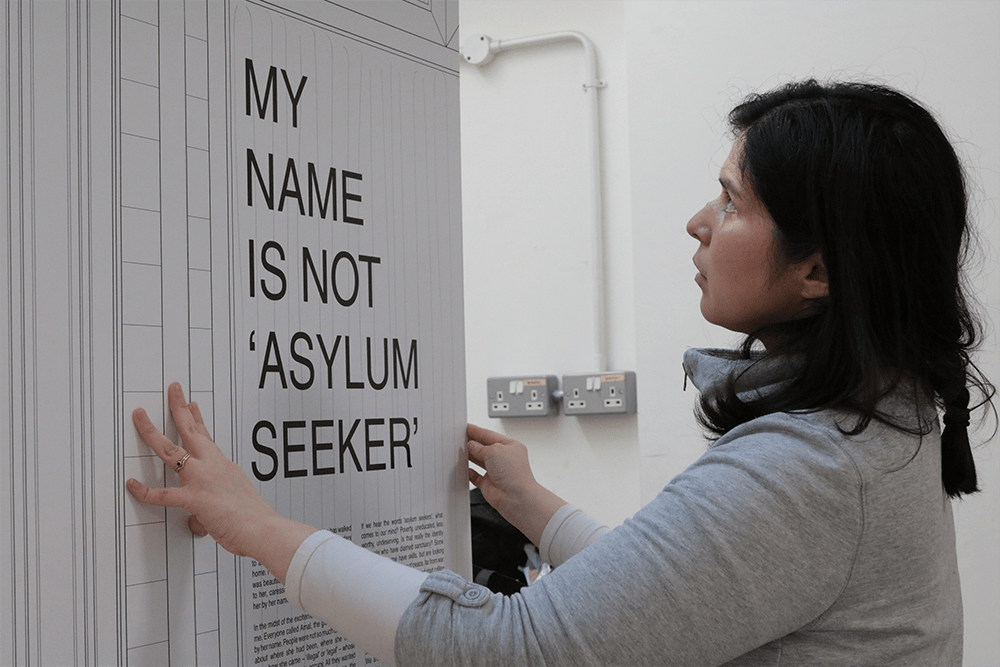“My name is not ‘asylum seeker’”
By Blog Editor, IOE Digital, on 2 May 2024

My name is not ‘asylum seeker’: Nadia Mendez Guevara assembles a section of the exhibition. Photo by Gabrielle Fadullon.
This week, ‘My name is not asylum seeker!’, a pop-up exhibition based on the SOLIDARITIES research project, opens at Halifax Central Library. The exhibition focuses on the everyday lives and experiences of people who have sought asylum in the UK and are waiting for a decision on their application. During the waiting period, people seeking asylum are ‘dispersed’ to different parts of the country and housed in dispersal accommodation, often of very poor quality; most are not allowed to work.
Typically, research on migration, urban multiculture, and diversity has focused on global cities like London. More recently, new research looking at smaller towns and cities and their histories of migration and racial, ethnic, and other forms of diversity, has emerged. It was in this vein that we decided to focus our research on the two dispersal towns of Halifax and Doncaster – ‘ordinary, provincial’ places, to use Ben Rogaly’s terminology.
Halifax is a former mill town and has a history of Irish immigration, later followed by labour migration from Kashmir to work in the town’s textile industry.

The former Dean Clough Mill in Halifax. Photo by Rasha Kotaiche.
As part of our exhibition, the West Yorkshire Archive Service is curating a display about Halifax’s rich history of sanctuary. This includes Belgian refugees arriving during World War I, Basque children fleeing the Spanish Civil War (1936-39), refugees arriving in the aftermath of the Hungarian uprising (1956-57), and Tibetan refugees arriving in the 1960s.
Today, Halifax is a significant dispersal town for people in the asylum system. Most asylum seekers live in Park Ward, which ranks among the 10% most deprived neighbourhoods in the country.

Housing in Park Ward, Halifax. Photo by Rasha Kotaiche.
Doncaster also has a long history of migration. As Paul FitzPatrick of Doncaster Conversation Club writes in one of the exhibition captions:
Doncaster’s name recalls the Roman garrison, while the Frenchgate centre refers to a Norman presence. Modern times brought Dutch and German engineers, as well as Irish and Scots, and in the course of the twentieth century there were Belgian refugees, the “Windrush generation”, and the Poles and Ukrainians who settled after the Second World War alongside “new commonwealth migrants”.
Today, Doncaster is a significant distribution hub for multinational companies. The town is also home to people in the asylum system, awaiting the outcome of their claim. Increasingly, outlying villages are being used for asylum accommodation. As our research found, this can cause isolation as transport is expensive and important institutions and services, such as mosques, halal butchers, and community support networks are all in central Doncaster. Sometimes people have to choose between spending money on bus fares or buying food.

Housing in a former mining village near Doncaster. Photo by Rasha Kotaiche.
Questions around migration and asylum have become very fraught in the UK, one of the world’s richest countries. In recent weeks, the UK government has passed the Safety of Rwanda (Asylum and Immigration) Bill, which means that people seeking asylum in the UK risk being sent to Rwanda to have their asylum claim processed there. Rwanda is one of the world’s poorest countries. It ranked 161st out of 193 in the most recent UN Human Development Index and nearly half of the population live in multidimensional poverty. Senior UN officials have called on the UK government to reconsider its plans and sounded the alarm about the risk that the aforementioned Bill could have a harmful impact on global responsibility-sharing, human rights, and refugee protection.
During the increasingly shrill surrounding debate, we have heard very few voices of people with lived experience of flight and asylum. This is not because, as the writer and political activist, Arundhati Roy, has assessed more generally, they are ‘voiceless’, but because they are among the “deliberately silenced, or preferably unheard”.
As Nelson Gómez, one of the co-researchers on the SOLIDARITIES project, has written:
To be an asylum seeker, it’s like to have a tattoo on the forehead with all those 12 letters. Many people don’t like us, the most of them don’t understand why we are here, they don’t know our stories and have their own conclusions.
‘My name is not asylum seeker!’ centres and foregrounds the perspectives and views of people in the asylum system living in dispersal accommodation in Halifax and Doncaster. These are people with names, hopes, disappointments, and dreams. As Faith Nyamakanga and Sanaa El-Khatib, two of the co-researchers, wrote:
We are people. We have rights. So, respect and feel for us. Welcome us and call us by our names, because my name is not ‘asylum seeker’.
‘My name is not asylum seeker!’ is at Halifax Central Library until Thursday 13 June 2024. It is free to visit. From Monday 17 June, the exhibition will be at DANUM in Doncaster. See also our online gallery.

‘Getting by’: Nadia Mendez Guevara assembles of a section of the exhibition. Photo by Gabrielle Fadullon.
The exhibition is based on research carried out by Mette Louise Berg and Eve Dickson from UCL, together with a group of people with personal experience of the asylum system: Abby Gómez, Arsalan Ghasemi, Faith Nyamakanga, Misbah Al-Misbahi, Nelson Gómez, and Sanaa El-Khatib, and two organisations supporting them: St Augustine’s Centre, Halifax, and Doncaster Conversation Club. The exhibition is designed by Nadia Mendez Guevara.
To read more about the research see ‘Social Research for our Times: Thomas Coram Research Unit past, present and future’, and ‘Asylum Housing in Yorkshire: a case study of two dispersal areas’.
 Close
Close



